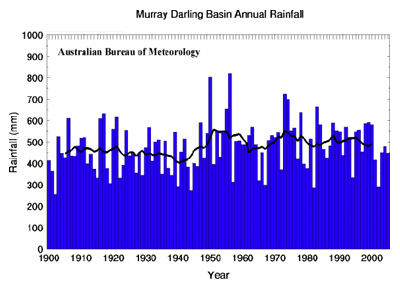Is the current drought another sign of climate change? Is renewable energy a real solution? The rainfall record has a few clues, and it is also worth considering how land and water management practices have changed over the last 100 years including in the Murray Darling Basin -- the food bowl of Australia.
Not so many years ago the Australian community was frightened that large tracts of land would be lost to salt. We were told that the rich farming lands of the New South Wales Riverina would be destroyed by rising ground water. Less than 2 per cent of the NSW Riverina ended up being affected by shallow water tables (PDF 10MB).
In fact even before the current drought, groundwater levels in the Murray, Murrumbidgee and Coleambally irrigation areas -- the regions considered most at risk in eastern Australia -- were falling. They were rising in the 1970s but falling in the 1990s. The general fall in groundwater levels was mostly a result of farmers and the Murray Darling Basin Commission putting in place a sophisticated drainage management plan. This included salt interception schemes designed to evaporate water while collecting salt. The focus was on getting rid of water and there is some evidence to suggest that this has caused parts of the environment to become artificially dehydrated.
Rising ground water is no-longer considered a threat to food production in the Murray Darling Basin. The boogey man is now climate change, and according to the popular press and some meteorologists, it is responsible for the current drought.
Geological history and modelling, including by the National Center for Atmospheric Research in Colorado, indicates that as the world warms it will generally get wetter. Yet we have a drought in southern Australia. This drought has been attributed by some to the hole over the Antarctic, which combined with global warming, has increased the temperature gradient between the equator and the Antarctic and changed wind patterns resulting in an increase in atmospheric pressure over southern Australia.
Then again the low rainfall may be just part of a natural cycle.
The Australian Bureau of Meteorology has information on rainfall right back to 1900. The rainfall record for the Murray Darling Basin (see chart below) shows there have been periods of as low rainfall in the past. The 11-year rolling average, the trend line shown in chart, indicates there has been no general increase or decrease in rainfall over the last 100 years. Carbon dioxide levels have increased by about 30 per cent over this same period.

Indeed the rainfall record for the Murray Darling Basin would suggest it is drawing a long bow to blame the current drought on climate change.
Rainfall may not have been exceptionally low, but there is certainly a water shortage and not just in the Murray Darling Basin. Metropolitan Australia is also suffering. But perhaps the water shortage in our cities has more to do with a lack of investment in water infrastructure coupled with a steady increase in population, than global warming? Perhaps water shortages in the Murray Darling Basin have been exacerbated by how we are now managing the landscape based on a past fear of rising ground water?
It is perhaps easier to just blame climate change and announce funding for solar panels and wind farms, than to ask the really hard questions and implement practical, but less emotionally compelling, solutions. For example, in Brisbane, Sydney and Melbourne we could start waste water recycling, except that we don't like the idea of drinking "recycled sewage". In the NSW Riverina it might be worth the technicians having a critical looks at the official drainage management plan and checking that all the water being evaporated is worth its salt!
The Western Australian Water Corporation knows that the low inflows into Perth's dams are not only a consequence of lower rainfall, but exacerbated by more trees growing in the water catchment. Studies have shown that about as much water could be saved by cutting down some trees, as building the expensive desalination plant. The government is now well advanced with the desalination plant, but still undertaking an extensive community and stakeholder consultation process (PDF 1.12MB) on the potential ecological impact of thinning.
Governments are frightened to make some of the necessary and practical decisions which could alleviate some of our water problems because they might be unpopular. But it is disingenuous to suggest, as both sides of politics have, that by reducing carbon dioxide emission in Australia, we can somehow stop droughts or climate change. Australia is responsible for less than 2 per cent of global carbon dioxide emissions. Global carbon dioxide emissions are going to continue to increase as China and other developing nations consume more energy -- regardless of how many wind and sun farms we build in Australia.
In summary, there is a water shortage in Australia but rainfall has not been exceptionally low and it is indeed drawing a long bow to blame climate change. In places as diverse and distant as Perth and the Murray Darling Basin, the drought may have almost as much to do with low inflow from particular land and water management practices as low rainfall. Blaming the current drought on climate change and investing in renewable energy may be fashionable, but it is not a real solution to our current water woes -- there are more practical solutions.

No comments:
Post a Comment